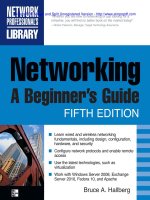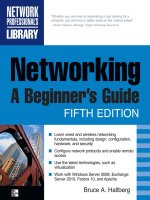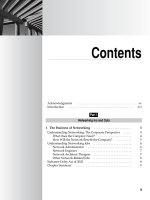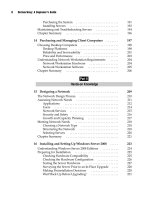Networking: A Beginner’s Guide Fifth Edition- P18 ppsx
Bạn đang xem bản rút gọn của tài liệu. Xem và tải ngay bản đầy đủ của tài liệu tại đây (553.68 KB, 5 trang )
67
Chapter 6: Understanding Network Hardware
Putting together all the necessary pieces in the proper way is the art of network
design. Chapter 15 discusses important aspects of assembling these devices so they work
together optimally, but first you need to know what they are and what they can do. The
following sections discuss these essential network devices.
Repeaters
A repeater is a device that extends the distance of a particular network run. It takes a
weak network signal in on one side, boosts the signal, and then sends it out its other
side. You most often see repeaters on Thin Ethernet networks, but they are available for
virtually any network connection. For instance, if you need to run a 100Base-T Cat-5
cable longer than 100 meters (328 feet), a repeater enables you to double that distance.
Repeaters operate at the physical layer of the OSI networking model. They do
not have the intelligence to understand the signals they are transmitting. Repeaters
merely amplify the signal coming in either side and repeat it through their other side.
(Remember that they also amplify any noise on the cable!) Repeaters are used to connect
only the same type of media, such as 10Base-2 Thin Ethernet to 10Base-2 Thin Ethernet,
or Token Ring twisted-pair to Token Ring twisted-pair. In practice, repeaters are usually
used with 10Base-2 networks (Thin Ethernet), which are discussed in Chapter 4.
Repeaters do have a small amount of intelligence that can be useful. They can
separate one of their connections from the other when there is a problem. For example,
consider two segments of Thin Ethernet that are connected using a repeater. If one of
those segments is broken, the repeater allows the good segment to continue working
within itself. Users on the good segment will be unable to connect to resources on
the broken segment, but they can still use the good segment without trouble. (But
remember that this capability does you little good if your servers are on the broken
segment and your workstations are on the good segment!) Figure 6–1 shows a network
extension using repeaters.
Figure 6-1. Using repeaters to extend network length (10Base-2 Thin Ethernet shown)
68
Networking: A Beginner’s Guide
Hubs and Concentrators
Intelligent LAN concentrators—usually just called concentrators or, even more simply,
hubs—are used to connect network nodes to network backbones. Nodes are connected
to hubs in a physical star fashion (cables fan out from the hub to each node), whether
they are used for a star topology or a ring topology network (these topologies are
discussed in Chapter 4). A simple network might consist of just a hub or two; smaller
networks usually don’t require a network backbone.
Hubs are available for virtually any network media type, with the higher-end units
using replaceable modules to support multiple media types. For example, you can
purchase a high-end hub chassis that can house both Ethernet and Token Ring modules.
You can purchase hubs in a variety of sizes, ranging from those that support only
2 workstations to those that support more than 100 workstations. Many network
designers use stackable hubs, which usually support 24 node connections each. These
hubs are often used in concert with switches, which are discussed in the next section.
Hubs have two important properties:
N Hubs echo all data from each port to all the other ports on the hub. Although
hubs are wired in a star fashion, they actually perform electrically (logically)
more like a bus topology segment in this respect. Because of this echoing, no
filtering or logic occurs to prevent collisions between packets being transmitted
by any of the connected nodes.
N Hubs can automatically partition (in this context, cut off) a problematic node
from the other nodes—in effect, shutting down that node. Such partitioning
occurs if a cable short is detected, if the hub port is receiving excessive packets
that are flooding the network, or if some other serious problem is detected
for a given port on the hub. Automatic partitioning keeps one malfunctioning
connection from causing problems for all of the other connections.
Hubs are becoming much more sophisticated. They often have a number of
advanced built-in features, including the following:
N Built-in management, where the hub can be centrally managed over the
network, using SNMP or other network management protocols and software.
N Autosensing of different connection speeds. For example, Ethernet hubs that
can automatically detect and run each node at either 10 Mbps (10Base-T) or
100 Mbps (100Base-T) are common.
N High-speed uplinks that connect the hub to a backbone. These usually operate
at ten times the basic speed of the hub. (For example, for a 100 Mbps hub, the
uplink ports might run at 1 Gbps.)
N Built-in bridging and routing functions, which make it unnecessary to use
separate devices to perform bridging and routing.
N Built-in switching, where nodes on the hub can be switched instead of shared.
69
Chapter 6: Understanding Network Hardware
When ordering a hub, it’s important to know how many nodes you want to
connect, how much bandwidth each requires, and what type of network backbone is
being used. Backbones can be anything from shared 10 Mbps Thin Ethernet, to 100
Mbps 100Base-TX, to higher-speed backbones. Your choice of a backbone technology
depends on the total amount of bandwidth that you need and the various other
network design criteria that you must meet.
Each hub is a separate collision domain, or an area of the network in which collisions
can occur. Connecting all hubs together in some fashion generally results in a larger
collision domain, encompassing all the hubs. The exception to this rule is a configuration
where all the separate hubs are connected to a switch (see the next section), which keeps
each hub in its own collision domain. Figure 6–2 shows an example of a network
using hubs.
Switches
Switches, as their name implies, can switch connections from one port to another, and
they can do so rapidly. They are connection-oriented and dynamically switch among
their various ports to create these connections. Think of a train yard, with many trains
coming in on some tracks and leaving on other tracks. The yard manager orders the
Figure 6-2. A typical hub arrangement
Common
backbone
cable
70
Networking: A Beginner’s Guide
track “switches” to take place so the trains can get to their destination. A network
switch is much like the yard manager, except that the switch directs packets rather than
trains and uses Ethernet cabling rather than train tracks to transport its cargo.
NOTE Switches are a lot like bridges, except that they have many ports and otherwise look like
hubs. You might think of a switch as a bridge with multiple ports.
Because switches form one-to-one connections between any two ports, all the ports
coming into a switch are not part of a single collision domain. In this sense, the switch
acts as a sort of super bridge (bridges are discussed in the next section).
Switches are often used to connect a number of hubs to a much faster backbone. For
example, suppose that you have 10 hubs, each with 24 workstation nodes connected. If
you simply connect all the hubs together on a common backbone, all 240 workstations
would share a single collision domain, which could hurt performance quite a bit.
Instead, a much better approach is to install a 12-port switch and connect each hub to
one of the ports on the switch. For instance, it is common to use 100Base-T Ethernet
for workstation connections, but 1000Base-T (or some other faster network connection)
for the backbone. This allows all the traffic being generated by each of the 10 hubs to
continue to run at about a 100 Mbps connection speed to the servers, even though all
the hubs are sharing the backbone. Figure 6–3 illustrates this approach.
NOTE Switches often are used simply to connect two given ports (such as traffic from port 5 to
port 21, for instance), but they are also intelligent enough to echo certain types of broadcast packets
to all ports simultaneously.
Figure 6-3. A network built using hubs and switches
Switch
Hubs
Server
71
Chapter 6: Understanding Network Hardware
Switches have become inexpensive and are blazingly fast. For local area network
(LAN) connections, switches make more sense than hubs, partly because of their cost
and their relative simplicity. In fact, purchasing bridges has become difficult, as switches
now dominate the market.
Additionally, most new networks eschew hubs in favor of a 100 percent–switched
approach. In fact, it’s virtually impossible to purchase hubs any longer, because
manufacturers typically offer only switches. (You may still be able to purchase very
small hubs, with four to eight ports, but even in these small applications, switches are
preferable and not much more expensive.)
It’s important that you understand the difference between hubs and switches, because
you may still encounter hubs installed in existing networks. For new networks, you will
use switches exclusively. Doing so dramatically reduces the opportunity for network
packet collisions, which are more likely in a hub arrangement.
Bridges
Bridges are, in a nutshell, more intelligent versions of repeaters. Bridges can connect
two network segments together, but they have the intelligence to pass traffic from one
segment to another only when that traffic is destined for the other segment. Bridges are used
to segment networks into smaller pieces. Some bridges can span different networking
systems and media, such as from coaxial Thin Ethernet to twisted-pair Token Ring.
As you might recall, repeaters operate at the physical layer (layer 1) of the OSI
networking model. Bridges operate one layer higher, at the data-link layer (layer 2).
Bridges examine the media access control (MAC) address of each packet they encounter
to determine whether they should forward the packet to the other network. Bridges
contain address information about all the parts of your network, through either a static
routing table that you program or a dynamic, learning-tree system that discovers all the
devices and addresses on the network automatically.
Is It Better to Use Fewer Large Switches or More Small Switches?
Larger switches that can host hundreds of connections within a single chassis are
generally more powerful than their smaller 24-port siblings, and they tend to
have more built-in redundancy, such as redundant power supplies in the unit and
so forth. However, sometimes it’s easier and less expensive to build a network
using smaller 24-port switches. You can simply purchase an extra 24-port unit as
a hot-swap backup (a backup unit that can be quickly swapped in to take the place
of a failed unit) that you can manually implement at a moment’s notice. The only
real disadvantage to this approach is that the redundancy is not automatic. If one
24-port switch fails, you’ll need to move its connections to the backup switch. In
contrast, a larger unit can switch to redundant features automatically. As always,
consider such trade-offs carefully for your particular company and its needs.









